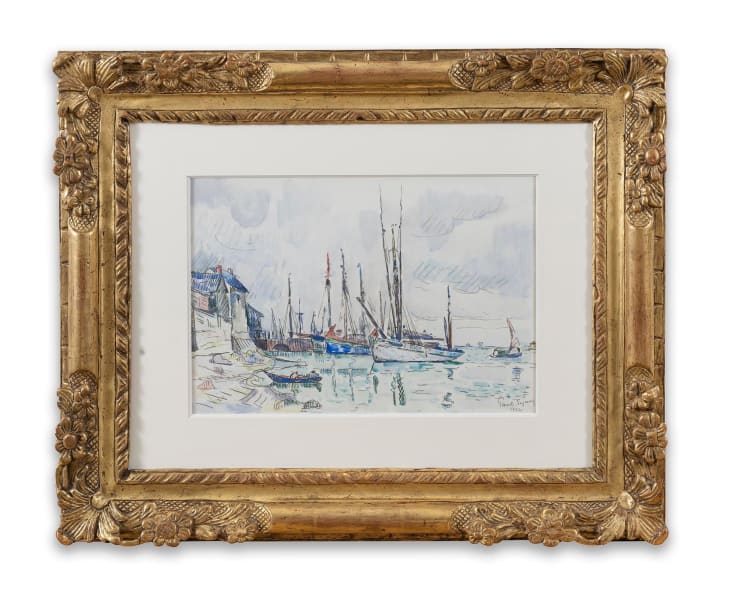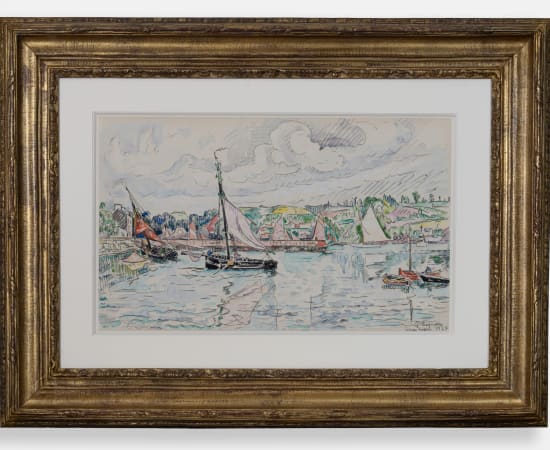Paul Signac (1863-1935) French
Works
Biography
Paul Signac stands as one of the foremost masters of color theory and a pioneering force in the development of modern art. A central figure in the Post-Impressionist movement, Signac was not just a painter, but a visionary who redefined the role of color in creating form and emotion. Best known for his pioneering work in Pointillism, Signac embraced a method of applying pure color directly onto the canvas, a technique that would influence entire generations of artists.
Trained under the influence of Georges Lemmen and Henri-Edmond Cross, Signac’s early exposure to the work of Seurat led him to explore the use of color as a scientific endeavor. His commitment to the Divisionist technique—splitting colors into tiny, distinct dots of pigment—emerged from his desire to capture light and atmosphere with unprecedented precision. However, unlike his contemporaries, Signac extended the technique beyond its origins in landscape painting, applying it to port scenes, portraits, and even abstract forms.
Signac’s mastery lay in his ability to combine the precision of his method with a deep emotional resonance. His vibrant, shimmering compositions of the Mediterranean coastline, particularly those of the South of France, exude a sense of rhythmic serenity, where each brushstroke contributes to a larger harmony. His work reflects not just an analytical approach to color, but an exploration of the soul of the landscape itself—a vision of both outer beauty and inner truth.
Throughout his career, Signac was a tireless advocate for the artistic community, helping to establish the Société des Artistes Indépendants and participating in numerous exhibitions. His legacy, now represented in leading institutions such as the Musée d'Orsay, the Art Institute of Chicago, and the Tate Gallery, is one of both innovation and intellectual rigor, making him a central figure in the evolution of modernist art.
At Bailly Gallery, Signac’s work finds a natural resonance with the gallery’s commitment to artists whose exploration of form, color, and technique transcends conventional boundaries. His paintings offer more than just a visual experience; they are an invitation to contemplate the interplay between science, nature, and emotion. For the discerning collector, Signac remains a master of both composition and color, whose work endures as a cornerstone of modern art’s most transformative movements.
Trained under the influence of Georges Lemmen and Henri-Edmond Cross, Signac’s early exposure to the work of Seurat led him to explore the use of color as a scientific endeavor. His commitment to the Divisionist technique—splitting colors into tiny, distinct dots of pigment—emerged from his desire to capture light and atmosphere with unprecedented precision. However, unlike his contemporaries, Signac extended the technique beyond its origins in landscape painting, applying it to port scenes, portraits, and even abstract forms.
Signac’s mastery lay in his ability to combine the precision of his method with a deep emotional resonance. His vibrant, shimmering compositions of the Mediterranean coastline, particularly those of the South of France, exude a sense of rhythmic serenity, where each brushstroke contributes to a larger harmony. His work reflects not just an analytical approach to color, but an exploration of the soul of the landscape itself—a vision of both outer beauty and inner truth.
Throughout his career, Signac was a tireless advocate for the artistic community, helping to establish the Société des Artistes Indépendants and participating in numerous exhibitions. His legacy, now represented in leading institutions such as the Musée d'Orsay, the Art Institute of Chicago, and the Tate Gallery, is one of both innovation and intellectual rigor, making him a central figure in the evolution of modernist art.
At Bailly Gallery, Signac’s work finds a natural resonance with the gallery’s commitment to artists whose exploration of form, color, and technique transcends conventional boundaries. His paintings offer more than just a visual experience; they are an invitation to contemplate the interplay between science, nature, and emotion. For the discerning collector, Signac remains a master of both composition and color, whose work endures as a cornerstone of modern art’s most transformative movements.
Enquire



